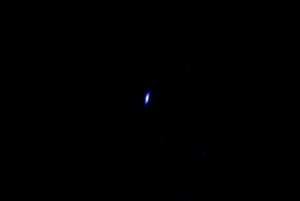Post
Pale Blue Dot
15 September 2013
 NRAO/AUI/NSF
NRAO/AUI/NSFThe image above is a radio image of Voyager 1. It was taken from the Very Long Baseline Array, which is a collection of 10 radio telescopes scattered from Hawaii to the Virgin Islands. It captures the faint radio signal of the distant probe. That pale blue dot is the most distant object made by humans.
The radio strength of Voyager 1 is about 23 watts. That signal is directed toward Earth, but Voyager is about 15 billion kilometers from Earth, so by the time the probe’s signal reaches us its power is less than an attowatt, or a billionth of a billionth of a watt. That faint signal is the only information we have from a probe that left our planet 36 years ago.
Of course it isn’t enough to simply detect the signal from Voyager 1, we must receive the signal the way you might receive a radio signal, or a mobile phone call. That requires even greater sensitivity, which is why it requires large radio telescopes to communicate with Voyager. We have to be able to hear Voyager’s faint messages, and we have to send radio responses that are powerful enough and focused enough for Voyager to receive.
Yesterday I wrote about how Voyager 1 had entered interstellar space, but had only begun its journey to the edge of our solar system. It will eventually leave our Sun’s grasp, since it has enough speed to escape the Sun’s gravity, but it will become silent long before then. In another 5 – 10 years it won’t have enough power to operate its instruments. That’s part of what makes this current milestone so significant. Voyager 1 has not only reached interstellar space, but it has told us it did.
That pale blue dot, a radio blip in a radio dark sky, is a part of us. It is an 800 kg, car sized, nuclear-powered computer that we launched into space to explore the solar system. Our curiosity drove us to create it, and our intelligence allowed us to build it. And after a 36 year journey to interstellar space, it continues to communicate with its creators.
One pale blue dot looking at another one.